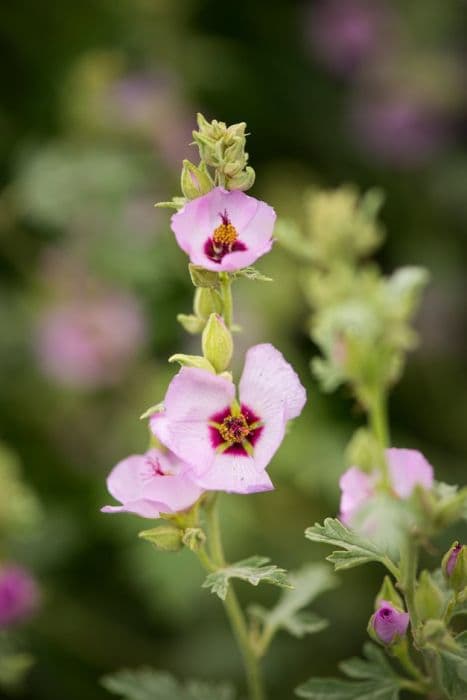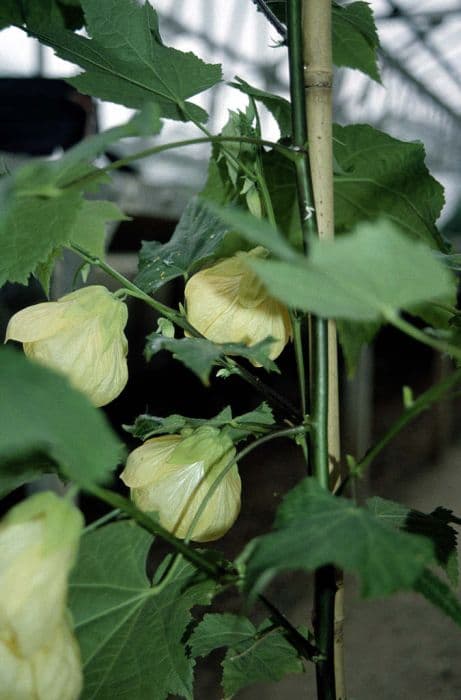Desert Mallow Sphaeralcea 'Hopleys Lavender'

ABOUT
Sphaeralcea 'Hopleys Lavender', commonly known as Hopleys Lavender Globemallow, is a flowering perennial plant that is characterized by its rounded, bushy form. It boasts a dense array of green, fuzzy foliage which serves as the backdrop for its vibrant flowers. The leaves of the plant are small and gray-green in color, with a lobed shape that gives them a somewhat maple-like appearance. The flowers of Hopleys Lavender Globemallow are its most striking feature. They emerge in clusters on the tips of the plant's stems, presenting a soft, soothing lavender hue. Each individual bloom resembles a miniature hollyhock or hibiscus, exhibiting a cup-shaped form with five rounded petals. These blossoms are known for their delicate appearance and their ability to attract pollinators such as bees and butterflies to the garden. Throughout the blooming season, Hopleys Lavender Globemallow becomes a focal point in any garden space due to its profusion of lovely flowers and its resilient, low-maintenance nature. The plant's presentation of gentle lavender against the soft greenery makes it an attractive choice for gardeners looking to add a touch of serene color and cottage charm to their landscapes.
About this plant
 Names
NamesFamily
Malvaceae.
Synonyms
Hopley's Lavender Globe Mallow, Lavender Globemallow.
Common names
Sphaeralcea 'Hopleys Lavender'.
 Toxicity
ToxicityTo humans
Generally, the Globe Mallow (Sphaeralcea) has not been reported to be toxic to humans. There is little to no information available that suggests the 'Hopleys Lavender' cultivar of Globe Mallow presents any toxicity to humans when touched or ingested. However, as with any plant not intended for consumption, it is always advisable to exercise caution and keep it out of reach of children, who might accidentally ingest plant parts.
To pets
Globe Mallow (Sphaeralcea) is also not commonly known to be toxic to pets such as dogs and cats. There are no widespread reports of the 'Hopleys Lavender' cultivar causing toxicity in pets. Nonetheless, as individual pets can have unique sensitivities, it is recommended to monitor pets around plants and to discourage them from ingesting any non-food plant materials to avoid any potential gastrointestinal upset.
 Characteristics
CharacteristicsLife cycle
Perennials
Foliage type
Deciduous
Color of leaves
Green
Flower color
Lavender
Height
3 feet [0.91 meters]
Spread
2 feet [0.61 meters]
Plant type
Shrub
Hardiness zones
6
Native area
North America
Benefits
 General Benefits
General Benefits- Aesthetic Appeal: Adds a splash of color to gardens with its lovely lavender blooms.
- Drought Tolerance: Well-suited to dry climates, reducing the need for frequent watering.
- Pollinator Friendly: Attracts bees, butterflies and other beneficial insects, supporting biodiversity.
- Low Maintenance: Requires minimal upkeep compared to more demanding plants.
- Heat Resistance: Thrives in hot conditions, making it ideal for warm regions.
- Soil Versatility: Adaptable to a variety of soil types, including poor soils.
- Long Blooming: Provides color throughout the growing season with a lengthy bloom time.
- Wildlife Habitat: Can serve as shelter and food source for local wildlife.
- Deer Resistance: Not typically favored by deer, which can help prevent garden damage.
 Medical Properties
Medical Properties- This plant is not used for medical purposes.
 Air-purifying Qualities
Air-purifying QualitiesThis plant is not specifically known for air purifying qualities.
 Other Uses
Other Uses- Sphaeralcea 'Hopleys Lavender', also known as Desert Mallow, can be used in cottage gardens to create an informal mixed border with its soft, romantic hue.
- Desert Mallow is suitable for rock gardens due to its tolerance for dry, poor soils and its ability to add a splash of color among the stones.
- The plant can be integrated into prairie-style plantings to contribute to the ecology by providing nectar-rich flowers for pollinators like bees and butterflies.
- Desert Mallow can serve as a transitional plant in wilder parts of the garden, blending cultivated areas with the surrounding landscape.
- It can be used as a ground cover for large, sunny areas where its sprawling habit helps stabilize the soil and suppress weeds.
- Desert Mallow's drought-resistant qualities make it ideal for xeriscaping, contributing to water conservation efforts in gardening.
- The plant's long-blooming flowers can be cut and used in fresh flower arrangements to add a delicate, airy touch.
- In urban environments, Desert Mallow can brighten up road verges and public spaces with low-maintenance landscaping requirements.
- When planted in mass, it can create a vivid display of color in public parks or large garden settings, which can be used for visual impact and enhancing visitor experience.
- Due to its moderate height, Desert Mallow can be used as a background plant in a perennial bed, providing a consistent backdrop for shorter, seasonal flowers in the foreground.
Interesting Facts
 Feng Shui
Feng ShuiThe plant_name is not used in Feng Shui practice.
 Zodiac Sign Compitability
Zodiac Sign CompitabilityThe plant_name is not used in astrology practice.
 Plant Symbolism
Plant Symbolism- Resilience and Survival: Sphaeralcea 'Hopleys Lavender', commonly known as Desert Mallow, often grows in arid and tough landscapes, symbolizing the ability to endure challenging conditions and thrive.
- Healing: Desert Mallow has been used in traditional medicine, representing healing and the soothing of physical or spiritual ailments.
- Protection: The tough nature of the plant signifies protection against adversity and the sheltering aspect of the plant's growth habit.
- Adaptability: Its capability to adapt to harsh environments signifies flexibility and the capacity to adjust to changing situations.
- Beauty and Joy: The plant’s vibrant lavender flowers symbolize the bringing of beauty and joy to barren landscapes, much like adding positive moments to one’s life.
 Water
WaterDesert Mallow prefers deep but infrequent watering to establish a strong root system. During the growing season, water approximately once every 7 to 10 days, providing enough water to soak the soil to a depth of around 10 inches. This could typically amount to around 1 to 2 gallons depending on soil type and environmental conditions. During the winter dormancy period, reduce watering to a bare minimum or according to rainfall, ensuring the soil does not remain soggy to prevent root rot. Always allow the soil to dry out between watering sessions.
 Light
LightDesert Mallow thrives in full sun exposure where it can receive at least 6 to 8 hours of direct sunlight daily. The plant is best suited for a spot that mimics its native habitat, with bright and unfiltered light throughout the day. Avoid placing it in areas with too much shade, as this can hinder its growth and flowering.
 Temperature
TemperatureDesert Mallow is heat tolerant and can survive in temperatures up to 100 Fahrenheit, although it prefers a range of 60 to 90 Fahrenheit for optimal growth. The plant can tolerate a minimum temperature down to about 20 Fahrenheit, but it's best to protect it from frost. Maintaining it within its ideal temperature range will ensure healthy foliage and vibrant blooms.
 Pruning
PruningPrune Desert Mallow to maintain its shape and promote bushier growth. Light pruning can be done in early spring to remove any dead or damaged growth from winter. If necessary, cut back by one-third in late winter or early spring before the onset of new growth. Pruning at this time helps to invigorate the plant for the coming season.
 Cleaning
CleaningAs needed
 Soil
SoilThe best soil mix for Desert Mallow should be well-draining and sandy with some organic matter. Ideally, the soil pH should be slightly acidic to neutral, ranging from 6.0 to 7.5. Amend regular garden soil with perlite or coarse sand and compost to increase drainage and fertility.
 Repotting
RepottingDesert Mallow typically does not require frequent repotting. It should be repotted once it has outgrown its current container which is generally every 2 to 3 years. Choose a pot only one size larger to avoid excess soil moisture retention.
 Humidity & Misting
Humidity & MistingDesert Mallow thrives in low to moderate humidity conditions. It is well-suited to the arid conditions found in its native habitat, so it does not require high humidity levels indoors.
 Suitable locations
Suitable locationsIndoor
Ensure full sun, well-draining soil, infrequent water.
Outdoor
Plant in full sun, well-drained soil, water sparingly.
Hardiness zone
5-9 USDA
 Life cycle
Life cycleSphaeralcea 'Hopleys Lavender', commonly known as Hopleys Lavender Globemallow, begins its life cycle as a seed, often sown in spring in well-drained soil in a location with full sun exposure. Upon germination, the seedling emerges and develops its first true leaves, gradually growing into a bushy, herbaceous perennial with grey-green foliage. During the growing season, typically in late spring to summer, it produces abundant lavender-pink flowers that attract pollinators and may continue blooming intermittently into fall. After pollination, the flowers develop into dry, papery fruits containing seeds that will disperse to create new plants. As a perennial, Hopleys Lavender Globemallow will die back to the ground in winter in colder climates but will remain evergreen or semi-evergreen in milder regions. The plant resumes growth from the rootstock the following spring, repeating its life cycle.
 Propogation
PropogationPropogation time
Spring-Early Summer
Sphaeralcea 'Hopleys Lavender', commonly known as desert hollyhock, is best propagated through cuttings. The most suitable time for taking cuttings is late spring to early summer, when the plant's growth is vigorous. To propagate by cuttings, a gardener would find a healthy, non-flowering stem and cut a 4 to 6-inch (roughly 10 to 15 cm) length, just below a node. The lower leaves are stripped off, and the cut end can be dipped in rooting hormone to encourage root development. The cutting is then placed in a pot filled with a mixture of peat and perlite or a similar well-draining propagation medium, ensuring that it is kept moist but not soggy. A plastic cover or bag can help maintain humidity while the cutting establishes roots, which typically takes a few weeks. Once the roots are established, the new plant can be potted up into a larger container with regular potting mix to continue growing.









